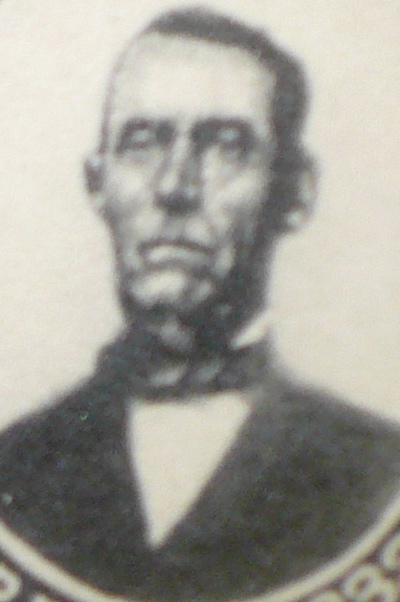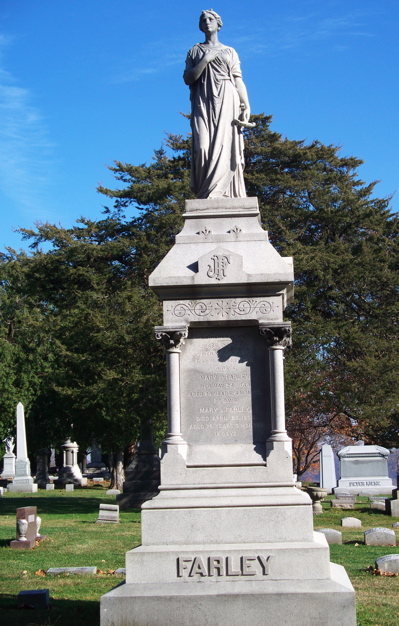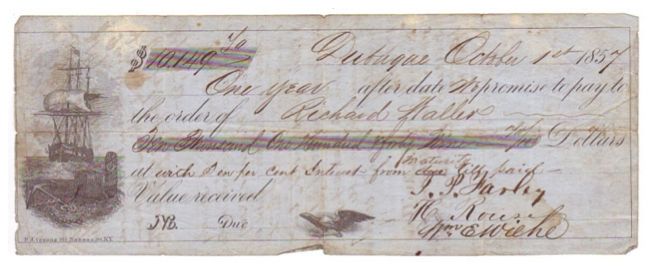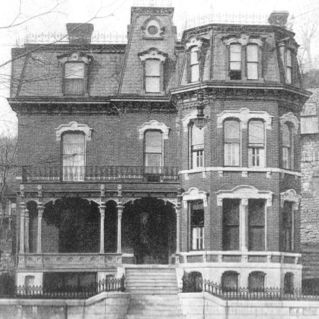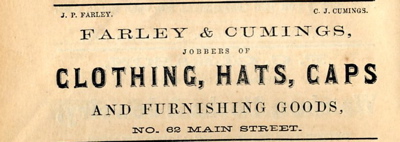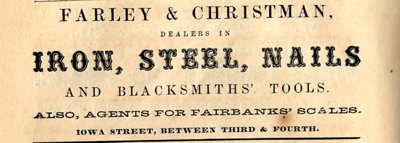Encyclopedia Dubuque
"Encyclopedia Dubuque is the online authority for all things Dubuque, written by the people who know the city best.”
Marshall Cohen—researcher and producer, CNN
Affiliated with the Local History Network of the State Historical Society of Iowa, and the Iowa Museum Association.
FARLEY, Jesse P.: Difference between revisions
No edit summary |
No edit summary |
||
| Line 159: | Line 159: | ||
Source: | Source: | ||
1. Hudson, David; Bergman, Marvin; and Horton, Loren. | 1. Hudson, David; Bergman, Marvin; and Horton, Loren. The Biographical Dictionary of Iowa. Iowa City: University of Iowa Press, 2008, P. 151 | ||
2. "Dubuque Sought Business Methods From Beginning," Telegraph Herald, March 27, 1921, p. 14. Online: http://news.google.com/newspapers?id=bi5eAAAAIBAJ&sjid=SmANAAAAIBAJ&pg=6644,4092622&dq=james+fanning+dubuque&hl=en | 2. "Dubuque Sought Business Methods From Beginning," Telegraph Herald, March 27, 1921, p. 14. Online: http://news.google.com/newspapers?id=bi5eAAAAIBAJ&sjid=SmANAAAAIBAJ&pg=6644,4092622&dq=james+fanning+dubuque&hl=en | ||
| Line 167: | Line 167: | ||
4. Hudson, p. 151 | 4. Hudson, p. 151 | ||
5. Oldt, Franklin T. | 5. Oldt, Franklin T. History of Dubuque County. Chicago: Western Historical Company, 1880, p. 786-787 | ||
6. Sommer, Lawrence J. | 6. Sommer, Lawrence J. The Heritage of Dubuque; An Architectural View, Tel Graphics, East Dubuque, Illinois, 1975 p. 94 | ||
7. Hudson, p. 151 | 7. Hudson, p. 151 | ||
| Line 181: | Line 181: | ||
11. Sommer, p. 96 | 11. Sommer, p. 96 | ||
12. Donovan, Frank P. Jr. | 12. Donovan, Frank P. Jr. Iowa Railroads. Iowa City: University of Iowa Press, 2000, p. 211 | ||
[[Category: Politician]] | [[Category: Politician]] | ||
[[Category: Business Leader]] | [[Category: Business Leader]] | ||
[[Category: Cemetery Marker]] | [[Category: Cemetery Marker]] | ||
Revision as of 19:14, 12 February 2014
Family History: http://wc.rootsweb.ancestry.com/cgi-bin/igm.cgi?op=GET&db=danandnicky&id=I5522
FARLEY, Jesse P. (Tennessee, Apr. 2, 1813--Dubuque, IA, May 8,1894). MAYOR. Farley came to Dubuque in the spring of 1833, but did not permanently settle here until that fall after making a contract to build a house and opened a store, Farley, Norris & Co. (1) In September, 1837 he brought his family to their new home.
In 1840 the Jesse P. Farley and Company store was Dubuque's only brick commercial building. He was a principal owner and investor in the Key City Planing Mill and KEY CITY STEAM BAKERY. (2) He helped organize the Dubuque Insurance Company and the DUBUQUE CENTRAL IMPROVEMENT COMPANY. In 1844 Farley was authorized by the city council to construct a POWDER MAGAZINE. In 1850 he established a line of steamboats between St. Paul and St. Louis. As president of the Dubuque and St. Paul steamer line, Farley consolidated the first steamer line in Dubuque--the Galena, Dunleith, and Minnesota Packet Line--with his own. This created the GALENA, DUBUQUE, DUNLEITH AND MINNESOTA PACKET COMPANY usually referred to the Minnesota Packet Company. He was a member of the wholesale grocery firm of Farley, James & Co., and of Farley & Christman, wholesale dealers in hardware, and Farley, Rouse & Co., dealers in heavy machinery. (3) In 1858 when he closed his dry goods store, he was one of the ten wealthiest people in Dubuque County. (4)
Farley was elected to the board of town trustees in 1840. The following year when the government was reorganized with a mayor and council, he became a member of the city council and served from 1841 to 1842. He did not hold public office again until 1851 when he returned to the city council and served as mayor the following year.
During his term of office the custom of the early settlers to enter and cut
timber on government land for their own private gain became an issue. The
custom had become so firmly grounded in 1852 that when they were taken into
court by government agents they became indignant and in January of that year
held a large meeting at Dubuque to protest against any interference with such
custom. A steady revenue was obtained from the sale of city lots. This was a
state of affairs not fully appreciated by the city fathers, in view of the
lack of such revenues in other cities. In April, 1852, an appropriation of $20
was made to pay for an oyster supper to the city officers. At this time 300
forest trees for the public square were contracted for. At the suggestion of
Charles Corkery the methods, or lack of methods, of keeping the city records
were reorganized and improved. A temporary quarantine hospital was located a
quarter of a mile south of Webb's old furnace below Dirty Hollow.
Bogy's steam ferry boat was required to land only between Fourth and Fifth
streets. Fanning's ferry landed at Second and Fourth streets. Fanning's ferry
landed at Second and Fourth streets. Fanning commenced suit against Gregoire
and Bogy, FANNING V. GREGOIRE AND BOGY alleging they were interfering with
his ferry rights. The council had granted to Gregoire and Bogy ferry rights
against the advice of the city attorney.
The city calaboose was in the second story of the market house. The temporary
quarantine hospital was opened about June 1, 1852, and cost $325; mattresses
cost $8. It was agreed at this time that the government's plans for the harbor
and the city's plan conflicted in several important particulars. In June, 1852,
the city borrowed $10,000 and issued bonds for the loan; the sum was used in
street and sewer improvements. The vote stood — For the loan 131, against it
46. There were found shallow places in Barney's cut; they were deepened.
L. H. Langworthy exchanged ten acres adjoining the hospital for a tract called
"Graveyard" on the hill at the northern boundary. In 1852 the city becoming
delinquent in the payment of county tax on city lots, was ordered by County
Judge Lovell to make payment or take the consequences. The $10,000 in city
bonds sold for $10,438.89 in New York city; the city received net $10,188.89.
Steps to raise Locust Street above high water from Fifth south to the city
limits were taken in April, 1852. Sealed bids to raise all streets in the
southern section above high water were called for in August.
In April a fire engine was ordered from Hunnerman & Co.
Treasurer O'Halloran, in October, 1852, roused the ire of the council by
making charges against them which reflected on their integrity; a committee
was appointed to see what action if any should be taken. Several meetings
were held and much difference of opinion was expressed. A draft of the
council was refused payment by Mr. O'Halloran on a disputed point, whereupon
he was fined $100 by the unanimous vote of the council. The draft was for
$3,000, which called for 612 sovereigns at $4.90 each and $1.20 in change.
But the treasurer had only offered to give for sovereigns $4.85 each, thereby
causing a loss of $30.60 to the agent or the city. The treasurer the next day
claimed that the market value of sovereigns in New York was only $4.85. Legal
action resulted, Mr. Burt serving as counsel for the city and Mr. Clark as
counsel for Mr. O'Halloran. Due charges were preferred against the latter,
to which Judge Clark demurred on the ground of want of jurisdiction.
The treasurer finally asked for a compromise on a proposition suggested
by one of the aldermen and approved by the mayor. The council refused to
accept the compromise offered. Mr. Jennings, also representing the treasurer,
appealed to the council not to pass the expelling resolution, declaring that
action was taken "to save the treasurer harmless from loss in the receipt of
currency." The mayor and Mr. Stout, alderman, opposed the resolution. Mr. Burt
spoke at length for the city. The resolution removing him from office passed,
Mr. Stout alone voting in the negative. Robert C. Waples, after a sharp contest
in the council, was chosen treasurer to succeed Mr. O'Halloran. The latter was
ordered to turn over all books, etc., belonging to the city and make final
report.
Permission to cut a channel through the outer island opposite Barney's cut
was granted to a number of citizens. The lower part of Main street was paved
in 1852. A new market place for the northern section was established between
Eleventh and Twelfth streets on White; cost, $2,500.
Private individuals claiming an extension of their lots into the public
cemetery caused contention and bitterness in 1852; there was a strong demand
for a new and better cemetery at once. The old graveyard at what is now
JACKSON PARK was first laid out in 1833-34, and was fenced by subscription.
In 1853 the new cemetery was first opened, lots were sold and improvements
were made. People whose fences had protected in part the old cemetery now
removed them, leaving the graves exposed to cattle and hogs.
Early in 1853 the new territory brought within the city limits was attached
to the old wards. In February. A loan of $20,000 was desired to carry on the
following improvements: To continue the present harbor work; to extend the
work on the levee; to improve the main roads leading out of the city; to secure
grounds for public building, including schoolhouses; to purchase fire apparatus;
to improve streets; to put in operation a system of common schools as per
charter. The city vote on the question of borrowing $20,000 was 111 for the
loan and 55 against it.
For schools $10,000 of the $20,000 loan was used. Temporary markets were permitted
in 1853. Bee Branch was being improved. Washington Fire Company No. I presented
its constitution in October, 1853, and asked for apparatus and buildings. A mass
meeting in January, 1853, petitioned the council to buy an up-to-date fire engine
and at once proceeded to organize hook and ladder and hose companies.
In 1853 there was a strong element in the city which began to oppose the
construction of the canal along the city front; they demanded that the work on
the canal should be abandoned and the inner and other sloughs should be filled.
Their plan meant the ultimate filling of all the sloughs and islands out to
the main river channel. By the spring of 1853 work on the canal was not
profitable to the contractors and operations languished. In 1852-3
WAPLES CUT afforded access of boats to the wharf; it was where the
ICE HARBOR is now.
Early in 1853 the corporate limits were extended. In June, 1853, Dubuque
succeeded in securing the post office distributing station from Galena.
An well attended meeting of the citizens to consider the propriety and utility
of building one or more causeways from the main land to the river was held early
in 1854 and resolutions favoring that project were passed and referred to the
city council. Two-thirds of the citizens petitioned the council to pave Main
Street from First to Eighth streets, the citizens and the city each to bear
one-half of the expense. In September, 1854, the council voted four to three
in favor of submitting to the voters the question of a $50,000 loan to be used
in building causeways to the river. During 1854 Main street was macadamized
and guttered, its pavements were improved and sheds and awnings in front were
done away with. In September, 1854, there was paid at one time for improvements
on the Lorimier Hollow Road the sum of $14,375.56. The estimated cost of the
lower causeway was $39,353. In November, 1854, the city secured a deed to that
portion of the [[[PLANK ROAD]] within the city limits. City water works were
demanded in November, 1854, to take the place of the water peddlers. On November
21 the first gas pipes were laid on Main Street.
In January, 1855, H. L. Stout and sixteen others, upon petition, were granted
the exclusive privilege of supplying the city with water by water works.
Seventy-five citizens petitioned to have Sixth street extended to the river,
but this was evaded or refused and the council called for proposals to extend
First and Seventh streets to the river. The council offered a reward of $500
for information leading to the conviction of any person guilty of arson within
the city limits. In January, 1855, the proposition of a company of citizens to
fill in lands on the front upon certain conditions was refused by the council.
As public sentiment and judgment favored some such plan at this time, the
council finally called for plans to extend Seventh street to the river. The
city received four proposals to extend Seventh street to the river. (5)
In 1879 Dubuque architect F. D. Hyde designed a home for Farley near WASHINGTON PARK. Costing $20,000, the house was considered one of the city's finest, boasting twelve rooms, expensive plate glass windows, and five ornate fireplaces. (6)
Farley's business interests were wide-ranging. RAILROADS were one of his major business ventures. In 1853 along with Lucius Hart LANGWORTHY, Farley helped organize the DUBUQUE AND PACIFIC RAILROAD and served as its first president. (7) The city of Farley, along its tracks, is named in his honor. Farley lost much of his wealth in the Panic of 1857 and tried to recover it through the FARLEY AND LOETSCHER MANUFACTURING COMPANY.(8) He was the company's major stockholder and president until his death. (9)
Farley was appointed the reorganization manager of the Saint Paul and Pacific Railway when it entered receivership in 1873. Devoting seven years to the embattled railroad, Farley fought a lawsuit in the early 1890s against the Great Northern Railway over routes for the two lines. Refusing an offer of James J. Hill to settle for one million dollars, Farley carried the case to the United States Supreme Court. (10) To pay court costs including as much as $1,000 per hour to George Edmonds, an attorney, Farley mortgaged his factory and six hundred acres of land. The court ruled against him and Farley had to sell his home to the Sisters of Saint Francis for $15,000 to help pay his bills. This building, with many additions, became MARY OF THE ANGELS HOME. (11) Farley died two years later.
---
Source:
1. Hudson, David; Bergman, Marvin; and Horton, Loren. The Biographical Dictionary of Iowa. Iowa City: University of Iowa Press, 2008, P. 151
2. "Dubuque Sought Business Methods From Beginning," Telegraph Herald, March 27, 1921, p. 14. Online: http://news.google.com/newspapers?id=bi5eAAAAIBAJ&sjid=SmANAAAAIBAJ&pg=6644,4092622&dq=james+fanning+dubuque&hl=en
3. Dubuque County IAGenWeb-Biographical Directory: "Jesse Farley", http://iagenweb.org/dubuque/bio/Farley_JP.htm
4. Hudson, p. 151
5. Oldt, Franklin T. History of Dubuque County. Chicago: Western Historical Company, 1880, p. 786-787
6. Sommer, Lawrence J. The Heritage of Dubuque; An Architectural View, Tel Graphics, East Dubuque, Illinois, 1975 p. 94
7. Hudson, p. 151
8. Ibid.
9. Dubuque County Genealogy, "Jesse P. Farley," http://www.rootsweb.ancestry.com/~iadubuqu/biographies/jfarley.html
10. Hudson, p. 151
11. Sommer, p. 96
12. Donovan, Frank P. Jr. Iowa Railroads. Iowa City: University of Iowa Press, 2000, p. 211


